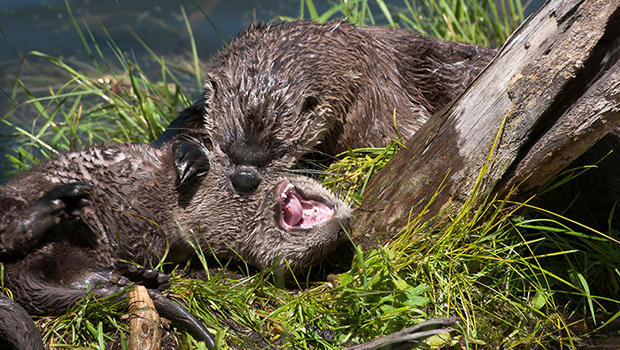Nature up close: Otters of Trout Lake
By contributing “Sunday Morning” nature videographer Judy Lehmberg:
I usually try to impart some information about the organisms you see during CBS’ “Sunday Morning”’s Nature segments, so this week I should tell you river otters spend much of their life in water; they eat fish, salamanders and other aquatic organisms; they can travel 20 miles in a day; and so on.
But I am not going to do that because these otters are my friends, and I want them to be your friends as well. I care more about them than I do many humans. In the summer I make trips just to visit them. So I am going to tell you about some of the cute stuff they do.
They live at Trout Lake in the spring and summer. Trout Lake is about a half-mile up a steep trail in the northeast corner of Yellowstone National Park. [I don’t know where they go the rest of the year.] It is a fairly small lake (about 12 acres), surrounded by high mountains and wonderful wild flowers.
On one side of the lake is a small creek, which native Yellowstone cutthroat go up in the spring to spawn. Cutthroat get their name from two red lines on either side of their chin. When they are spawning, the males have bright red sides and the larger ones develop a larger jaw, or kype. They are beautiful fish!
Otters have two speeds: stop and go. When they are switched to stop, they are sleeping, usually in their den. When they go, they are either chasing food, eating or playing. They love to play, even the adults. I am totally convinced mama otters have babies so they will have someone to play with. I’ve watched the mama otter in this video playing with her babies for over an hour at a time. The babies crawl all over mom while she play-bites, grooms them, and once even picked one of the babies up by the skin of its chest. It looked painful to me, but the baby went limp as a sock and didn’t seem to mind a bit.
I know biologists say babies play to learn and get ready for adulthood. That is probably true, but otter babies (and adults) play because it is fun. I’ve never seen Trout Lake otters do this, but on the Green River in Utah I watched four adult otters sliding down a mud bank into the river over and over. The second they hit the water, they swam to the edge, crawled out, went to the top of the slide and slid down again, usually on their backs head-first.
When they are hungry, mom chases down a nice cutthroat trout and then plays keep away with her babies. She frequently does that on a log with one or two babies on each side. She will turn towards one set of babies to avoid the others as she chews. This can go on for a few minutes but she eventually lets a baby “accidentally” catch the trout from her.
If she catches a salamander her behavior is different. She immediately gives one to a baby, except for a few she keeps for herself. (Maybe salamanders don’t taste as good as trout! I know they are easier to catch.) As they eat the salamanders they remind me of a kid with a popsicle. They hold it with two hands – well, paws really -- and crunch them down quickly. It does make me feel bad for the salamanders, but it is fun watching the otters.
Because the trail to Trout Lake is relatively short, there are a lot of people who come up there, some to fish, but most to see the cutthroat trout and, of course, the otters. When the otters are out a crowd of 20 or so people usually gathers. They all get really quiet and are absolutely enthralled with the spectacle. It is often as much fun to see their smiles as it is to watch the otters. And when the otters do something especially cute, a quiet, a respectful “Ahh” ripples through the audience.
I will mention one aspect of their biology because I think it is especially neat: They have delayed implantation. That means that after they mate, a sperm fuses with an egg, but it goes into a type of suspended animation for eight to ten months, during which time the fertilized egg doesn’t grow; it just kind of hangs around in the uterus. Once it does implant in the uterine wall, it obtains nutrients and develops in a little over 60 days.
If you are lucky enough to find yourself in Yellowstone in June, make the trip up to Trout Lake. I can’t promise you will see the otters, but you might, and I do promise you will see some beautiful trout and scenery as well.
Judy Lehmberg is a former college biology teacher who now shoots nature videos.
For more info:
- Judy Lehmberg (Official site)
- Judy Lehmberg’s YouTube Channel
To watch extended “Sunday Morning” Nature videos click here!

